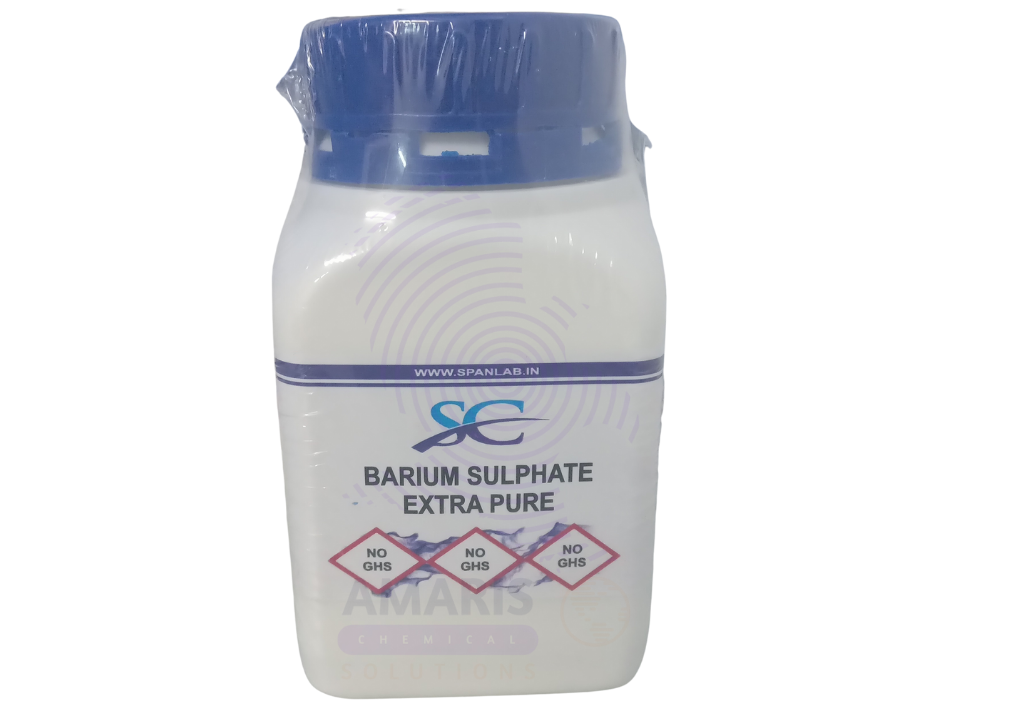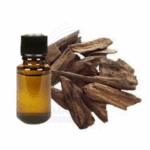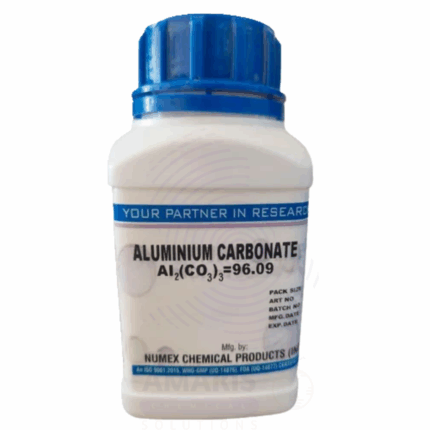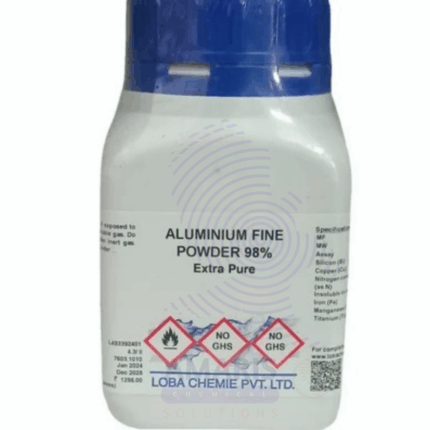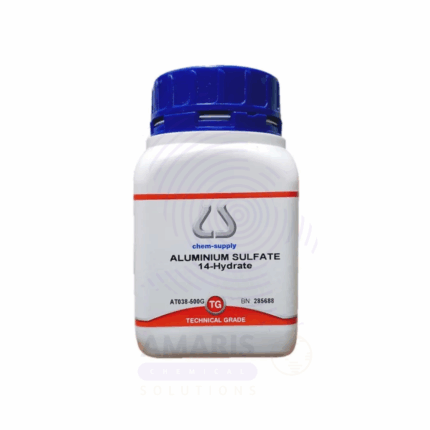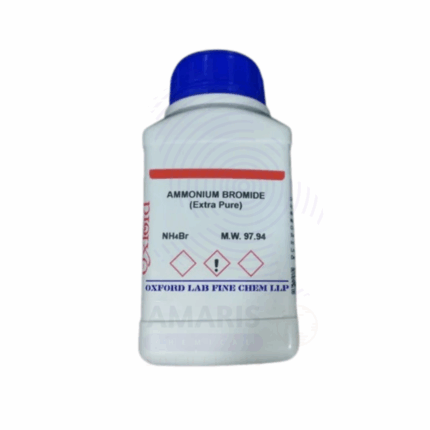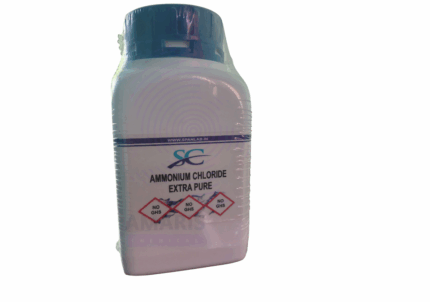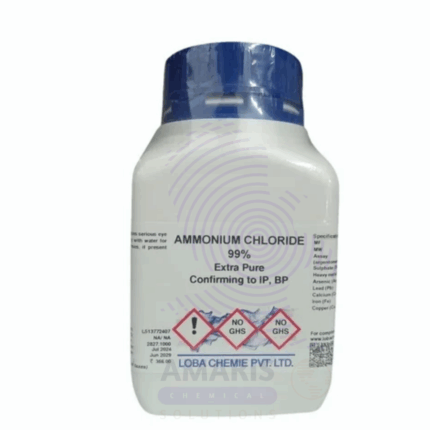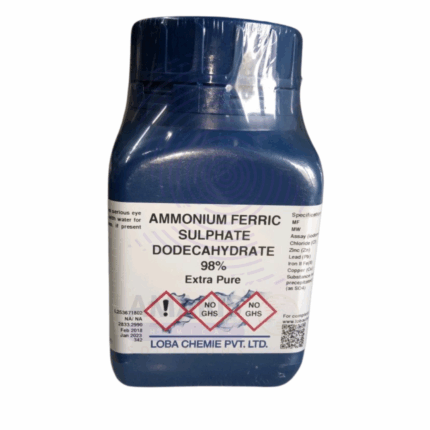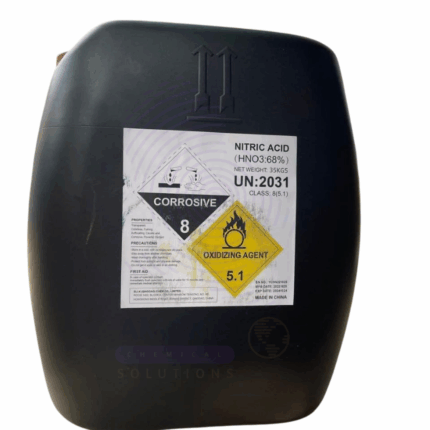Barium Sulphate Extra pure
$ 18.00 Original price was: $ 18.00.$ 17.76Current price is: $ 17.76.
Barium Sulphate Extra Pure is a high-purity, white, odorless crystalline powder known for its extreme insolubility in water and chemical inertness, making it highly useful in laboratory settings for qualitative analysis and gravimetric determinations. It is commonly employed in the detection and quantification of sulfate ions through precipitation reactions, as well as in studies involving solubility equilibria and surface chemistry. Its high density and stability also make it valuable in preparing calibration standards and radiopaque materials in research. The extra pure grade ensures minimal contamination, providing consistent and reliable results in sensitive analytical procedures. It should be stored in a dry, tightly sealed container to maintain its quality and prevent contamination.
Barium Sulphate Extra pure
Primary Uses
- Standard in Gravimetric Sulfate Analysis
- Barium sulphate is the precipitate formed in classic gravimetric determination of sulfate ions (SO₄²⁻) — this is one of the most precise methods in quantitative inorganic analysis.
- Reference Material for Instrument Calibration
- Due to its well-defined physical and optical properties, it’s used in X-ray diffraction (XRD) and infrared spectroscopy (IR) as a standard for calibration or sample matrix.
- Filler in KBr/IR Pellets for Spectroscopy
- Finely powdered BaSO₄ is used as a diluent or matrix for preparing solid samples in Fourier-transform infrared spectroscopy (FTIR) due to its minimal absorption in the IR range.
- Control Substance in Solubility and Ksp Studies
- As a model compound with very low solubility, it is widely used in experiments dealing with solubility product (Ksp) calculations and equilibrium demonstrations.
- Indicator of Sulfate in Qualitative Analysis
- Used to visually confirm the presence of SO₄²⁻ ions when Ba²⁺ solution is added — an essential part of classical qualitative group analysis.
Secondary Uses
- Demonstration of Precipitation Reactions
- An effective visual tool to teach double displacement reactions and concepts of ionic solubility in educational labs.
- Simulation of Radiodense Compounds (Non-medical Use)
- Used in research simulations that mimic radiodense behavior in imaging, though not used for clinical contrast media (those are pharma-grade and specially treated).
- Study of Particle Size and Crystallinity
- Its uniformity and low solubility make it useful in morphology studies using light scattering, microscopy, or sedimentation.
- Component in Laboratory Ceramic Research
- Sometimes used in experimental ceramic/glass formulations to study refractory behavior and phase stability.
- Environmental Chemistry Experiments
- Useful in remediation studies to simulate precipitation-based removal of sulfates or heavy metals from contaminated water systems.
| PACK SIZE |
500 grams Plastic Tin |
|---|
1. Basic Identification Attributes
- Chemical Name: Barium Sulphate
- CAS Number: 7727-43-7
- HS Code: 28332700 (Sulphates: of Barium)
- Molecular Formula: BaSO₄
- Synonyms:
- Baryte / Barite
- Barium sulphate
- Natural barium sulfate (when mined, not lab-prepared)
2. Physical & Chemical Properties
- Physical State: Fine powder or crystalline solid
- Color & Odor: White; odorless
- Melting Point: 1580 °C (decomposes)
- Boiling Point: Not applicable (decomposes)
- Density: ~4.5 g/cm³
- Solubility:
- Water: Practically insoluble (<0.002 g/100 mL at 20 °C)
- Acids: Slightly soluble in hot concentrated sulfuric acid
- pH (suspension): Neutral (6–8)
- Vapor Pressure: Not applicable
- Conductivity: Non-conductive
3. Safety & Hazard Attributes
- Hazard Class (GHS):
- Not classified as hazardous under GHS (low toxicity due to insolubility)
- NFPA Ratings:
- Health: 1
- Flammability: 0
- Reactivity: 0
- Exposure Limits:
- OSHA PEL (as total dust): 15 mg/m³
- OSHA PEL (respirable fraction): 5 mg/m³
- Reactivity:
- Chemically inert under lab conditions
- Non-combustible
- Decomposes at high temperatures releasing SOx
4. Storage & Handling Attributes
- Storage Conditions:
- Store in a dry, cool area
- Avoid humidity or moisture ingress
- Incompatible Materials:
- Strong acids, especially hot concentrated sulfuric acid
- Container Type:
- Use plastic or glass jars with tight sealing
- Shelf Life:
- Indefinite under proper dry storage
- Special Handling:
- Use gloves and dust mask to avoid inhalation
- Handle in well-ventilated space
5. Regulatory & Compliance Attributes
- GHS Pictograms:
- None required
- Transportation Information:
- Not regulated as hazardous for transport
- Waste Disposal:
- Dispose of in accordance with local lab safety protocols
- Non-toxic, but avoid dust release
- Regulations:
- Listed in TSCA, REACH, IATA, IMDG
- Generally regarded as safe due to extreme insolubility
6. Environmental & Health Impact
- Ecotoxicity:
- Low risk to aquatic life
- Biodegradability:
- Inorganic compound; not biodegradable
- Carcinogenicity:
- Not classified as carcinogenic
- Bioaccumulation Potential:
- Negligible; not bioavailable due to insolubility
SAFETY PRECAUTIONS
- Personal Protective Equipment (PPE):
- Use lab coat, protective gloves (nitrile or latex), and safety goggles.
- Use a dust mask or respirator if handling powders in bulk.
- Handling:
- Avoid generating or inhaling dust.
- Handle in a well-ventilated area or under a fume hood if dusty.
- Though non-toxic in solid form, avoid ingestion or prolonged skin exposure.
- Storage:
- Store in a tightly sealed container.
- Keep in a dry, cool, and well-ventilated place.
- Label clearly and segregate from reactive substances.
- Hygiene Measures:
- Wash hands and exposed skin thoroughly after handling.
- Do not eat, drink, or smoke in areas where this chemical is handled.
FIRST AID MEASURES
- Inhalation:
- Move person to fresh air.
- If breathing becomes difficult, get medical attention.
- Skin Contact:
- Wash affected skin with plenty of water and soap.
- Remove contaminated clothing.
- Eye Contact:
- Rinse cautiously with water for at least 15 minutes.
- If irritation persists, seek medical help.
- Ingestion:
- Rinse mouth with water.
- Though poorly soluble and less toxic than other barium salts, seek medical attention as a precaution.
FIRE FIGHTING MEASURES
- Extinguishing Media:
- Use water spray, foam, dry chemical, or CO₂.
- Fire Hazards:
- Non-flammable and does not support combustion.
- In fire conditions, may release:
- Sulfur oxides (SOₓ)
- Barium oxides
- Protective Equipment:
- Wear full protective gear and self-contained breathing apparatus (SCBA) if involved in fire.
- Firefighting Instructions:
- Avoid inhalation of fumes.
- Prevent contaminated runoff from entering drains or waterways.


 Preservatives(food)
Preservatives(food) Flavor Enhancers
Flavor Enhancers Acidulants
Acidulants Sweeteners
Sweeteners Antioxidants
Antioxidants Colorants(food)
Colorants(food) Nutraceutical Ingredients (food)
Nutraceutical Ingredients (food) Nutrient Supplements
Nutrient Supplements Emulsifiers
Emulsifiers
 Collectors
Collectors Dust Suppressants
Dust Suppressants Explosives and Blasting Agents
Explosives and Blasting Agents Flocculants and Coagulants
Flocculants and Coagulants Frothers
Frothers Leaching Agents
Leaching Agents pH Modifiers
pH Modifiers Precious Metal Extraction Agents
Precious Metal Extraction Agents
 Antioxidants(plastic)
Antioxidants(plastic) Colorants (Pigments, Dyes)
Colorants (Pigments, Dyes) Fillers and Reinforcements
Fillers and Reinforcements Flame Retardants
Flame Retardants Monomers
Monomers Plasticizers
Plasticizers Polymerization Initiators
Polymerization Initiators Stabilizers (UV, Heat)
Stabilizers (UV, Heat)
 Antifoaming Agents
Antifoaming Agents Chelating Agents
Chelating Agents Coagulants and Flocculants
Coagulants and Flocculants Corrosion Inhibitors
Corrosion Inhibitors Disinfectants and Biocides
Disinfectants and Biocides Oxidizing Agents
Oxidizing Agents pH Adjusters
pH Adjusters Scale Inhibitors( water)
Scale Inhibitors( water)
 Antioxidants(cosmetic)
Antioxidants(cosmetic) Emollients
Emollients Fragrances and Essential Oils
Fragrances and Essential Oils Humectants
Humectants Preservatives
Preservatives Surfactants(cosmetic)
Surfactants(cosmetic) Thickeners
Thickeners UV Filters
UV Filters
 Fertilizers
Fertilizers Soil Conditioners
Soil Conditioners Plant Growth Regulators
Plant Growth Regulators Animal Feed Additives
Animal Feed Additives Biostimulants
Biostimulants Pesticides (Herbicides, Insecticides, Fungicides)
Pesticides (Herbicides, Insecticides, Fungicides)
 Active Pharmaceutical Ingredients (APIs)
Active Pharmaceutical Ingredients (APIs) Excipients
Excipients Solvents(pharmaceutical)
Solvents(pharmaceutical) Antibiotics
Antibiotics Antiseptics and Disinfectants
Antiseptics and Disinfectants Vaccine Adjuvants
Vaccine Adjuvants Nutraceutical Ingredients (pharmaceutical)
Nutraceutical Ingredients (pharmaceutical) Analgesics & Antipyretics
Analgesics & Antipyretics
 Analytical Reagents
Analytical Reagents Solvents(lab)
Solvents(lab) Chromatography Chemicals
Chromatography Chemicals Spectroscopy Reagents
Spectroscopy Reagents microbiology-and-cell-culture-reagents
microbiology-and-cell-culture-reagents Molecular Biology Reagents
Molecular Biology Reagents Biochemical Reagents
Biochemical Reagents Inorganic and Organic Standards
Inorganic and Organic Standards Laboratory Safety Chemicals
Laboratory Safety Chemicals Specialty Laboratory Chemicals(Special Laboratory Equipment)
Specialty Laboratory Chemicals(Special Laboratory Equipment)
 Demulsifiers
Demulsifiers Hydraulic Fracturing Fluids
Hydraulic Fracturing Fluids Scale Inhibitors(oil)
Scale Inhibitors(oil) Surfactants(oil)
Surfactants(oil) Drilling Fluids
Drilling Fluids
 Dyes and Pigments
Dyes and Pigments Bleaching Agents
Bleaching Agents Softening Agents
Softening Agents Finishing Agents
Finishing Agents Antistatic Agents
Antistatic Agents
 Admixtures
Admixtures Waterproofing Agents
Waterproofing Agents Sealants and Adhesives
Sealants and Adhesives Curing Compounds
Curing Compounds Concrete Repair Chemicals
Concrete Repair Chemicals Anti-Corrosion Coatings
Anti-Corrosion Coatings
 Surfactants(cleaning)
Surfactants(cleaning) Builders
Builders Enzymes
Enzymes Solvents (Cleaning)
Solvents (Cleaning) Fragrances
Fragrances
 Electronic Chemicals
Electronic Chemicals Catalysts
Catalysts Lubricants
Lubricants Photographic Chemicals
Photographic Chemicals Refrigerants
Refrigerants Automotive chemicals
Automotive chemicals Pyrotechnic Chemicals
Pyrotechnic Chemicals
 Biodegradable Surfactants
Biodegradable Surfactants Bio-based Solvents
Bio-based Solvents Renewable Polymers
Renewable Polymers Carbon Capture Chemicals
Carbon Capture Chemicals Wastewater Treatment Chemicals
Wastewater Treatment Chemicals
 Pigments
Pigments Solvents(paint)
Solvents(paint) Specialty Coatings
Specialty Coatings Binders/Resins
Binders/Resins Additives
Additives Driers
Driers Anti-Corrosion Agents
Anti-Corrosion Agents Functional Coatings
Functional Coatings Application-Specific Coatings
Application-Specific Coatings
 Fresh Herbs
Fresh Herbs Ground Spices
Ground Spices Whole Spices
Whole Spices Spice Blends
Spice Blends Dried Herbs
Dried Herbs
 Leavening Agents
Leavening Agents Dough Conditioners
Dough Conditioners Flour Treatments
Flour Treatments Fat Replacers
Fat Replacers Decoratives
Decoratives Preservatives(baking)
Preservatives(baking)
 Plasticizers & Softeners
Plasticizers & Softeners Reinforcing Agents
Reinforcing Agents Adhesion Promoters
Adhesion Promoters Vulcanizing Agents
Vulcanizing Agents Antidegradants
Antidegradants Blowing Agents
Blowing Agents Fillers & Extenders
Fillers & Extenders Accelerators & Retarders
Accelerators & Retarders